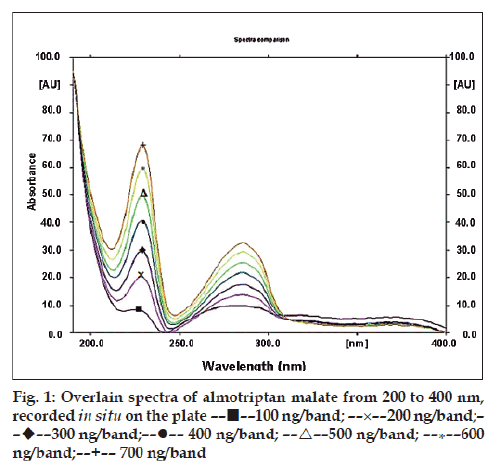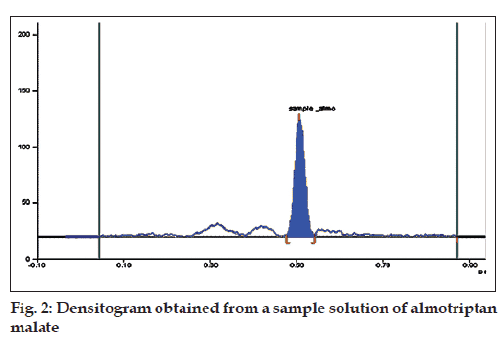- *Corresponding Author:
- B. Syamasundar
Department of Chemistry/Pharmacy, Acharya Nagarjuna University, Nagarjuna Nagar, Guntur-522 510, India
E-mail: profbsyamsundar@yahoo.co.in
| Date of Submission | 30 November 2009 |
| Date of Revision | 03 May 2010 |
| Date of Acceptance | 18 September 2010 |
| Indian J Pharm Sci 2010, 72 (5): 629-632 |
Abstract
A new, simple, precise and accurate high performance thin layer chromatographic method has been proposed for the determination of almotriptan malate in a tablet dosage form. The drug was separated on aluminum plates precoated with silica gel 60 GF 254 with butanol:acetic acid:water (3:1:1) was used as mobilephase. Quantitative analysis was performed by densitometric scanning at 300 nm. The method was validated for linearity, accuracy, precision and robustness. The calibration plot was linear over the range of 100-700 ng/band for almotriptan malate. The method was successfully applied to the analysis of drug in a pharmaceutical dosage form.
Keywords
Almotriptan malate, high-performance thin-layer chromatography, tablets
Almotriptan malate [1], a selective 5-hydroxytryptamine 1B/1D (5-HT1B/1D) receptor agonist, is chemically designated as 1- [ [ [3- [2-(dimethylamino) ethyl]-1H-indol-5-l]methyl] sulfonyl] pyrrolidine-(±)-hydroxy butanedioate (1:1), whose empirical formula is C17H25N3O2S–C4H6O5, with a molecular weight of 469.56. Almotriptan malate is a water soluble white to slightly yellow crystalline powder, which is used to treat severe migraine headaches and is available as Axert tablets. Forner et al. [2] and Bosch et al. [3] have synthesised almotriptan malate and have published the data in US5565447. A few procedures based on liquid chromatography have been reported for the quantitative determination of almotriptan in human plasma and urine. A HPLC method for the determination of process-related impurities in almotriptan malate was reported earlier [4]. Jansat et al. [5] have published a method based on HPLC for determining the levels of almotriptan in plasma. Fleishaker et al. [6] have reported a validated HPLC method for the determination of almotriptan concentrations in urine. Literature survey revealed that no analytical method for determination of almotriptan malate in pharmaceutical dosage forms has been reported thus far. This paper describes a simple, accurate, precise, and sensitive HPTLC method for determination of almotriptan malate in tablet dosage form. The proposed method was optimized and validated in accordance with guidelines suggested by International Conference on Harmonization (ICH) [7].
Methanol, butanol, toluene, ethyl acetate, acetic acid, hexane, acetone and dichloromethane (all are of Analytical Reagent grade) were obtained from Sisco Research Laboratories, Mumbai, India. Standard bulk drug sample of almotriptan malate (99.8% pure) was obtained as a gift sample from SMS Pharmaceuticals, Hyderabad, India. The pharmaceutical dosage form used in this study was Axert tablets with a declared content of 12.5 mg almotripan malate (Ortho McNell, USA)
A standard stock solution of almotriptan malate was prepared by dissolving 10 mg drug in 100 ml methanol to furnish a concentration of 100 μg/ ml. Chromatography was performed on 10×10 cm aluminum plates precoated with 250-μm layers of silica gel 60 GF254 (E. Merck, Darmstadt, Germany). Before use the plates were prewashed with methanol and activated at 110° for 5 min. Samples were applied to the plates as bands 6 mm wide and 10 mm apart by means of a Camag (Switzerland) Linomat V sample applicator equipped with a 100 μl syringe (Hamilton, Bonaduz, Switzerland). Linear ascending development was performed in a 10×10 cm twin trough glass chamber (Camag), with butanol-acetic acid-water 3:1:1 (v/v) as mobile phase and the chamber was presaturated with mobile phase vapour for 10 min. The development distance was 8.5 cm and the development time was approximately 60 min.
After chromatography the plates were dried in a current of air with the use of a air drier. Densitometric scanning was performed with a Camag TLC Scanner 3 at 300 nm for all measurements. The scanner was operated by Wincats software version 1.2.3. The source of radiation was a deuterium lamp emitting a continuous UV spectrum between 200 and 400 nm. The slit dimensions were 5 mm × 0.45 mm and the scanning speed was 20 mm/s.
After chromatographic development, bands were scanned over the range 200-400 nm (spectrum scan speed 20 nm/s) so that the drug could be estimated at 300 nm fig. 1, which is ascertained by taking the spectrum at different concentrations between 100–700 ng with 100 ng increment. Further it is also observed that spectra are similar in their behavior.
The standard stock solution of almotriptan malate (100 μg/ml) was applied on a TLC plate, in the range 1–7 μl, by use of the Linomat V sample applicator and 100 μl syringe. The plate was developed and scanned under the conditions described above. Each amount was analyzed fi ve times and peak areas were recorded. A calibration plot of peak area against respective amount was established for almotriptan malate.
Twenty tablets were weighed accurately and finely powdered. A quantity of powder equivalent to 10 mg almotriptan malate was weighed and transferred to a standard 100 ml volumetric flask containing approximately 50 ml methanol. The mixture was ultra sonicated for 5 min then diluted to volume with methanol. The solution was fi ltered using Whatmann 41 fi lter paper. One to seven microlitres of the fi ltrate was applied to a TLC plate. After development of chromatogram the peak area of the bands were measured at 300 nm and the amount of drug in each tablet was determined from the calibration plot. The analytical procedure was repeated six times for the homogenous powder sample.
The limit of detection of a compound is defi ned as the smallest level of analyte that gives a measurable response. LOD was determined by using the equation LOD= 3.3×σ/S. The limit of quantitation is the lowest concentration of a compound that can be quantified with acceptable precision and accuracy. LOQ was determined by employing the relationship LOQ=10×σ/S, where σ = the standard deviation of the response and S = the slope of the calibration curve.
To study intra-day and inter-day precision, three different concentrations of sample solutions were prepared and applied to the TLC plates. All the solutions were analyzed in triplicate on the same day and on three different days to record intra-day and inter-day variations in the results, respectively.
To check the accuracy of the method, recovery was measured by the addition of standard drug solution at three different levels (50, 100 and 150%) to preanalyzed sample solution (200 ng/band for almotriptan malate was selected so that after standard addition sample would be in the linear range). Three replicate estimations were carried out for each concentration level.
The effect of small, deliberate variation of the analytical conditions on the peak areas of the drugs was examined in order to assess the robustness of the method. The robustness of the method was checked for 200 and 700 ng/band for almotriptan malate.
For optimization of method, different mobile phase compositions were employed to achieve good separation. The method development was initiated by using different proportions of mobile phase consisting variety of solvents like: toluene:methanol:ethylacetate, dichloromethane:methanol, butanol:aceticacid:water, toluene:methanol:acetone, toluene:methanol:ethyla cetate:aceticacid, hexane:ethylacetate. Of these the mixture butanol-acetic acid-water 3:1:1 (v/v) was found to be suitable for the studies. The RF value of almotriptan malate was 0.53±0.01. The proposed HPTLC method was validated in terms of linearity, precision, accuracy, specificity and robustness. The calibration plot was found to be linear over the range 100–700 ng/band for almotriptan malate, with a correlation coeffi cient of 0.9994±0.0002. The LOD and LOQ were found to be 28.19 and 93.99 ng/ band, respectively. The values of percent relative standard deviations were found to be 0.23 and 0.51 for Intraday and inter day precision studies, respectively which indicate that the method is precise. The method was also evaluated by assay of commercially available tablets (Axert) containing almotriptan malate. The resulting densitogram for a sample solution of almotriptan malate is presented in fig. 2 indicating a concentration of 700 ng/band. Six replicate analyses were performed on accurately weighed amount of the tablets (Table 1). The percent assay was found to be 99.36±0.522 for almotriptan malate. To study the accuracy of the method, recovery studies were performed. For almotriptan malate, recovery ranged from 99.54 to 101.1% with values of percent RSD ranging from 0.21 to 0.61 indicating that the proposed HPTLC method is highly accurate (Table 2). To confi rm the specifi city of the proposed method, the solution of formulation was spotted on TLC plate, developed and scanned. It was observed that the excipients present in the formulation did not interfere with the sample peak. Study of the robustness of the method revealed that the peak areas were unaffected (RSD < 2%) by small changes in composition and volume of mobile phase indicating appreciable robustness of the method. The method validation parameters are presented in Table 3.
| Drug | Label claim | Amount found* | Recovery* % | RSD % |
|---|---|---|---|---|
| Almotriptan malate | 12.5 mg | 12.42 mg | 99.36 | 0.52 |
Table 1: Analysis of Marketed Formulation of Almotriptan Malate by Hptlc Method
| Sample | Excess of drug added to the analyte (%) | Theoretical content (ng) | Recovery* % | RSD % |
|---|---|---|---|---|
| Almotriptan | 50 | 300 | 99.54 | 0.21 |
| malate | 100 | 400 | 99.82 | 0.35 |
| 150 | 500 | 101.1 | 0.61 |
Table 2: Result From Recovery Studies of Almotriptan Malate
| Parameters | Results of almotriptan malate |
|---|---|
| Linearity (ng/band) | 100-700 |
| Correlation coefficient | 0.9994 |
| LOD (ng/band) | 28.19 |
| LOQ (ng/band) | 93.99 |
| Precision | |
| Interday (% RSD) | 0.51 |
| Intraday (% RSD) | 0.23 |
| Specificity | specific |
Table 3: Method Validation Parameters
The validated HPTLC method for almotriptan malate is simple, rapid, accurate, precise, sensitive, specifi c and robust and can thus be used for routine analysis of almotriptan malate in a tablet dosage form.
Acknowledgements
The authors wish to express their gratitude to SMS Pharmaceuticals, Hyderabad, India for the gift sample of pure almotriptan malate. One of us (A.S) is thankful to management of Hindu College of Pharmacy, Guntur, India for providing free access to the facilities and to carry out research work.
References
- Maryadele JO, Heckelman PE, Koch CB, Roman KJ. Editors. The Merck Index: an Encyclopedia of Chemicals, Drugs and Biologicals. 14th ed. Whitehouse Station NJ: Merck and Co Inc; 2006.
- Forner DF, Duran CP, Soto JP, Noverola AV, Maruti JM. Indolederivaties. US Patent 5565447. 1996.
- Bosch J, Roca T, Armengol M, Forner DF. Synthesis of 5-(Sulfamoyl methyl) indoles. Tetrahedron 2001;57:1041-48.
- Kumar AP, Ganesh VR, Rao DV, Anil C, Rao BV, Hariharakrishnan VS, et al. A Validated Reverse phase HPLC method for the determination of process related impurities in almotriptan malate API. J Pharm Biomed Anal 2008;46:792-98.
- Jansat JM, Tobed AM, Garcia E, Cabarrocas X, Costa J. Effect of food intake on the bioavilabilty of almotriptan, an anti migrane compounds in healthy volunteers: An open, randomized, crossover, single-dose clinical trial. Int J ClinPharmacolTher 2006;44:185-90.
- Fleishaker JC, Ryan KK, Jansat JM, Carel BJ, Bell DJ, Burke MT, et al. Effect of MAO-A inhibition on the pharmacokinetics of almotriptan, an anti migrane agents in humans. Br J ClinPharmacol 2001;51:437-41.
- International Conference on Harmonization (2005) ICH harmonized tripartite guidelines (Nov 2005), Validation of Analytical Procedures׃ Text and Methodology Q2 (R1).ICH, Geneva.







